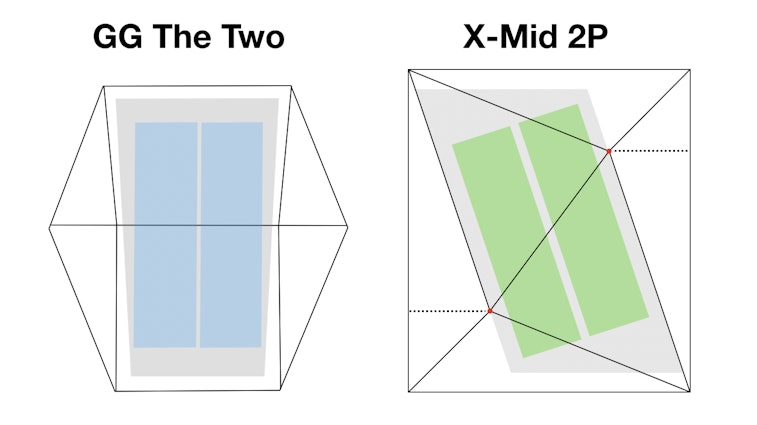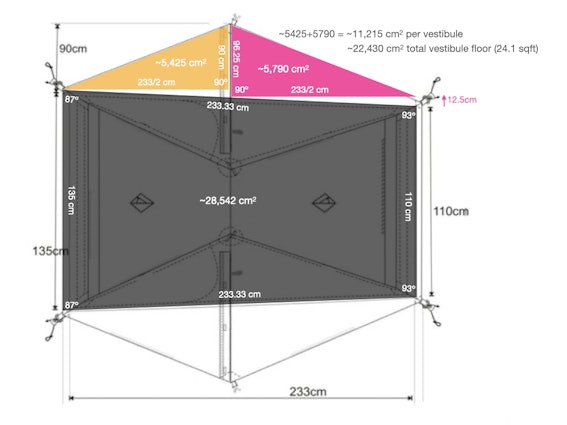Click to view our Accessibility Statement or contact us with accessibility-related questions




Showing 1 of 357 conversations about:
gimpster
57
Jul 23, 2019
bookmark_border

dandurston
5116
Dan Durston
Jul 23, 2019
bookmark_border
gimpsterThanks for the thoughtful questions. You raise some good questions and I am happy to explain further, because I think there is a lot more to this than first meets the eye.
First, I'll show scaled images of these tents, then talk about the basic shapes/designs, and then go into other differences like material choices. Below are these two tents roughly to scale, but with the caveat that it's hard to create a scaled diagram for The Two because the diagram that GG provides on their website is really inaccurate. For example, their diagram shows the peaks located over the sleeping area and thus with heavily inward sloping side walls, but their tent photos show the opposite where the peaks not over the floor and with vertical or slightly outward sloping mesh walls. So my floor area is accurate. The rest is more of an estimate but pretty close:


- Substantially more spacious tent with a longer/wider floor, more space by having the peaks further apart, and ability to fully utilize that space because it's a double wall
- About 50% more vestibule space
- Larger, easier to use doorways
- Double wall design is modular and protects users from contacting condensation
- Dual vents (vs none)
- Fabric is more waterproof and durable
- Higher end materials, hardware and construction
- Simpler 4 stake pitch
- No sag and UV resistant fabric
- Fabric doesn't absorb water weight
(Edited)
gimpster
57
Jul 23, 2019
bookmark_border
dandurstonThank you, that's a very helpful and thorough reply. It's great to hear you talk about the reasoning behind specific materials decisions and design, as I know those reasons are almost always more important than the spec list can easily represent. This really helps a lot in my decision making. I didn't catch the difference of the nylon material for the Two and that makes a good argument for me to go with your design, since I will mostly be using this in wooded (read: moist) environments and nobody likes packing wet gear into their pack.
dsowden13
26
Jul 23, 2019
bookmark_border
dandurstonThanks for taking the time Dan, every step of the way haha, very informative and this post certainly sealed the deal for me. I'll be picking up your X-Mid in the near future for sure!
Sweetjond
68
Oct 17, 2020
bookmark_border
dandurstonI'm with @dandurston - doing some basic geometry with GG's own floor diagram, I come up with a little over 11,000 sqcm per vestible or 24.1 square feet of total vestibule area. So GG's claim of 32 sq ft seems to be a 33% overstatement if their diagram's dimensions are labeled correctly. Their diagram is certainly not to scale, as you can see comparing the 90cm edge (upper left) to the 110cm edge (right side). Given that Dan & I computed nearly the same vestibule area via two totally different approaches, I'm inclined to believe their diagram is labelled correctly, and the 32 sq ft vestibule area claim from their site is what's wrong.



- Packed weight. The Two seems to be about 7oz lighter than this tent (when comparing the tent + fly).
- Vestibule size. The Two has a total vestibule area of 32sf vs 25sf with this tent.
- This one is subjective but from what I can tell The Two has a single layer tent design, which would make it easier to pitch while this tent appears to be a typical two layer design with a separate fly, which means more steps and time to pitch the tent.
- Price. Definitely The Two is the more expensive tent at $375 vs $250, but once the money is spent, all I'm concerned with is how well it performs for me when I'm in the woods.
I'd love to hear others thoughts on this comparison. For me, I'm leaning toward The Two based on the reasons above and despite the 50% higher price (buy once, cry once) but I'd love to be challenged on that. Also, does anyone know if the seams are taped on this tent?